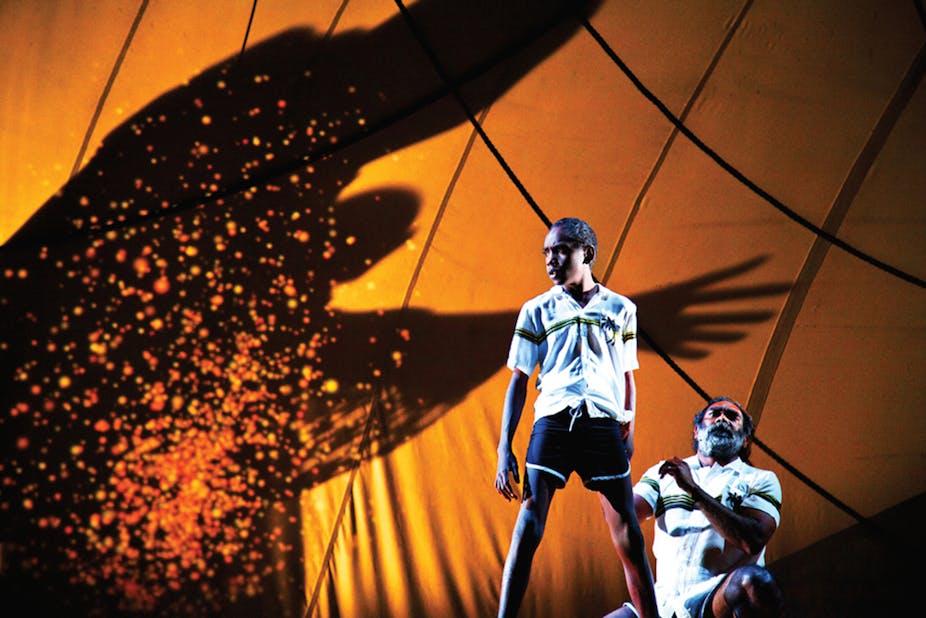Hipbone Sticking Out, the Big hART production now playing at the Melbourne Festival, begins in September 1983. We meet 16-year-old John Pat slowly dying, lying alone in a police cell in Roebourne.
We find ourselves in a scene from Flemish artist Jan Bruegel’s Orpheus in the Underworld, with the Greek God Pluto appearing to ferry the young John into the next world. But he is confronted by John as he would find him in 2014. This John is 47 years old and reluctant to act as a mere symbol within European theatrical conventions that seek to stylise Australia’s sorry record of Indigenous deaths in police custody.
This is our first clue to the complex multi-layered narrative that writer-director Scott Rankin has created in Hipbone Sticking Out. This is a narrative well aware of how a director’s imposition of dominant cultural traditions can mediate our versions of history.
The two Johns convince Pluto to help them travel back in time to understand how their history has ferried them to a prison floor in Roebourne. In doing do, they pare back the westernised theatrical traditions that bring Pluto to us in the first place.
This becomes the main theme of a narrative that traverses greats stretches of time and geography. We begin with the Dutch East India Company’s exploration of Australia in the 1600s. We move through to the disease, massacres and enslavement of the colonial era, which almost annihilated generations of Indigenous Australians.
As the layers of interconnected stories begin to unravel, the audience understands how tangibly this history of injustices perpetrated against generations of Indigenous Australians is linked to the subsequent tragedy of John’s death.
Multi-layered and ambitious
Hipbone Sticking Out is tremendously ambitious both theatrically and in terms of narrative. The piece manages to be entertaining and witty, as well as brutally truthful and uncompromising in its political aims.
It would be easy for this story to be didactic. But despite the utterly horrific content of this history – murders, rapes, loss of language and culture dot the narrative – Hipbone’s triumph is that this is not a story about victims.
Hipbone Sticking Out is the English translation of “Murujuga”, the name of the Burrup Peninsula in the Ngayarda languages. The peninsula is probably a place that many Australians have not seen. But it looms large in Hipbone as a kind of centrepoint of a new version of Australian history – one that acknowledges its brutality and injustice, but that also foregrounds the dynamic, living voices of contemporary Indigenous communities.
Using their own voices and story-telling practices, the people of Roebourne unveil their stories of Australia, creating an alternative history to the perception of Indigenous life as “past”.
The narrative is layered with animation that reflects both the iconic rock art of the Burrup Peninsula and urban art practice, and music that ranges from traditional Indigenous song and dance to Britney Spears and burlesque-style prancing across the stage.
Theatrically, the piece is rich. The angled stage is used to good effect and the projections and animations reflect the change of time, geography and cultural impact. The wordplay also deserves mention for its dark – and often hilarious – use of irony and sarcasm as well as unflinching honesty.
These techniques demand the audience acknowledge the importance of Indigenous Australian stories and histories, both brutal and hopeful. More importantly, the cast encourage the audience to “own” this history as “our story”.
Collaboration key to Hipbone Sticking Out
Big hART is a social change arts company, formed by Rankin, which brings marginalised or isolated communities together with artists to tackle social issues.
Established in 1992, Big hART has now worked with 43 communities and has produced 14 touring theatre works. Hipbone Sticking Out has emerged from collaborations forged by Big hART’s Yijala Yala project, a conservation agreement with the government that highlights and preserves the cultural heritage of the Murujuga and Dampier Archipelago in Western Australia.
While this might seem a project about conserving a history long past, Big hART has been working with traditional custodians and young people in this Pilbara town since 2010. The company has assisted this tiny community to interpret the way they live their cultural heritage through theatre, as well as film and interactive media.
Towards the end of the piece, we hear from the current Roebourne community about the struggles and triumphs of this tiny town. Actors use dialogue from John’s mother in a scene that is particularly arresting. It helps us to gain a better understanding of both John’s life and life in Roebourne today. We are told that if John had lived, he would have been a leader in his community, negotiating with government and industry on behalf of his people. John continues to be a leader even after his death.
As alluded to in the conclusion of Hipbone, John’s death became the catalyst for the 1987 Royal Commission into Aboriginal Deaths in Custody. While the police officers involved in the fatal altercation with John Pat were ultimately cleared, the Commission went on to make 339 recommendations for change. The Murru Concert and a new campaign, One in Two: Unlock the Future, continue to draw attention to the issue of Indigenous incarceration rates in Australia.
At the conclusion of Hipbone Sticking Out, John tells the audience the story isn’t over and that indigenous incarceration has to be tackled maragutharra - together. With Indigenous incarceration rates doubling since 1991 and more Indigenous deaths in custody reported this year, clearly the story is far from over.
Hipbone Sticking Out plays at the Melbourne Festival until 21 October. Details here.

